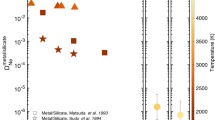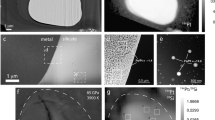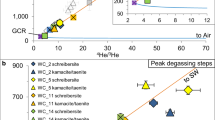Abstract
The chemical evolution of both the Earth’s atmosphere and mantle can be traced using noble gases1,2,3,4,5. Their abundance in mantle and atmosphere reflects a balance between the flux of noble gases from the Earth’s interior through magmatism, and the recycling of noble gases from the atmosphere back into the mantle at subduction zones. The flux of noble gases back into the mantle has long been thought to be negligible1. However, analyses of samples from the mantle now suggest that this recycling flux is more significant6,7,8, but the responsible mechanisms are unclear. Here we present high-pressure experimental measurements that demonstrate high solubility of noble gases in amphibole, an important hydrous mineral in altered oceanic crust9,10,11. Noble gas solubility correlates with the concentration of unoccupied A-sites, which consist of a pair of opposing tetrahedra rings. We conclude that A-sites are energetically favourable locations for noble gas dissolution in amphibole that could allow recycling of noble gases into the mantle by subduction of altered oceanic crust. As many hydrous minerals in subducting slabs, such as serpentine and chlorite, have lattice structures similar to the A-site in amphibole, we suggest that these minerals may provide even more significant recycling pathways7,11.
This is a preview of subscription content, access via your institution
Access options
Subscribe to this journal
Receive 12 print issues and online access
$259.00 per year
only $21.58 per issue
Buy this article
- Purchase on Springer Link
- Instant access to full article PDF
Prices may be subject to local taxes which are calculated during checkout



Similar content being viewed by others
References
Allegre, C. J., Hofmann, A. & Onions, K. The Argon constraints on mantle structure. Geophys. Res. Lett. 23, 3555–3557 (1996).
Kurz, M. D., Jenkins, W. J. & Hart, S. R. Helium isotopic systematics of oceanic island and mantle heterogeneity. Nature 297, 43–47 (1982).
Ballentine, C. J., Marty, B., Lollar, B. S. & Cassidy, M. Neon isotopes constrain convection and volatile origin in the Earth’s mantle. Nature 433, 33–38 (2005).
Pujol, M., Marty, B. & Burgess, R. Chondritic-like xenon trapped in Archean rocks: A possible signature of the ancient atmosphere. Earth Planet. Sci. Lett. 308, 298–306 (2011).
Moreira, M., Kunz, J. & Allegre, C. Rare gas systematics in popping rock: Isotopic and elemental compositions in the upper mantle. Science 279, 1178–1181 (1998).
Holland, G. & Ballentine, C. J. Seawater subduction controls the heavy noble gas composition of the mantle. Nature 441, 186–191 (2006).
Kendrick, M. A., Scambelluri, M., Honda, M. & Phillips, D. High abundances of noble gas and chlorine delivered to the mantle by serpentinite subduction. Nature Geosci. 4, 807–812 (2011).
Sumino, H. et al. Seawater-derived noble gases and halogens preserved in exhumed mantle wedge peridotite. Earth Planet. Sci. Lett. 294, 163–172 (2010).
Ito, E., Harris, D. M. & Anderson, A. T. Alteration of oceanic crust and geologic cycling of chlorine and water. Geochim. Cosmochim. Acta 47, 1613–1624 (1983).
Carlson, R. L. Bound water content of the lower oceanic crust estimated from modal analyses and seismic velocities of oceanic diabase and gabbro. Geophys. Res. Lett. 30, 2142 (2003).
Hacker, B. R. H2O subduction beyond arcs. Geochem. Geophys. Geosyst. 9, Q03001 (2008).
Ballentine, C. J. & Barfod, D. N. The origin of air-like noble gases in MORB and OIB. Earth Planet. Sci. Lett. 180, 39–48 (2000).
Mukhopadhyay, S. Early differentiation and volatile accretion recorded in deep-mantle neon and xenon. Nature 486, 101–104 (2012).
Caffee, M. W. et al. Primordial noble cases from Earth’s mantle: Identification of a primitive volatile component. Science 285, 2115–2118 (1999).
Trieloff, M., Kunz, J., Clague, D. A., Harrison, D. & Allegre, C. J. The nature of pristine noble gases in mantle plumes. Science 288, 1036–1038 (2000).
Holland, G., Cassidy, M. & Ballentine, C. J. Meteorite Kr in earth’s mantle suggests a late accretionary source for the atmosphere. Science 326, 1522–1525 (2009).
Parai, R., Mukhopadhyay, S. & Standish, J. Heterogeneous upper mantle Ne, Ar and Xe isotopic compositions and a possible Dupal noble gas signature recorded in basalts from the Southwest Indian Ridge. Earth Planet. Sci. Lett. 359, 227–239 (2012).
Tucker, J. M., Mukhopadhyay, S. & Schilling, J. G. The heavy noble gas composition of the depleted MORB mantle (DMM) and its implications for the preservation of heterogeneities in the mantle. Earth Planet. Sci. Lett. 355, 244–254 (2012).
Moreira, M. et al. He and Ne isotopes in oceanic crust: Implications for noble gas recycling in the mantle. Earth Planet. Sci. Lett. 216, 635–643 (2003).
Zaikowski, A. & Schaeffer, O. A. Solubility of noble gases in serpentine—implications for meteoritic noble gas abundances. Earth Planet. Sci. Lett. 45, 141–154 (1979).
Staudacher, T. & Allegre, C. J. Recycling of oceanic crust and sediments-the noble gas subduction barrier. Earth Planet. Sci. Lett. 89, 173–183 (1988).
Heber, V. S., Brooker, R. A., Kelley, S. P. & Wood, B. J. Crystal-melt partitioning of noble gases (helium, neon, argon, krypton, and xenon) for olivine and clinopyroxene. Geochim. Cosmochim. Acta 71, 1041–1061 (2007).
Parman, S. W., Kurz, M. D., Hart, S. R. & Grove, T. L. Helium solubility in olivine and implications for high 3He/4He in ocean island basalts. Nature 437, 1140–1143 (2005).
Kelley, S. Excess argon in K–Ar and Ar–Ar geochronology. Chem. Geol. 188, 1–22 (2002).
Damon, P. E. & Kulp, J. L. Excess helium and argon in beryl and other minerals. Am. Mineral. 43, 433–459 (1958).
Kumagai, H., Dick, H. J. B. & Kaneoka, I. Noble gas signatures of abyssal gabbros and peridotites at an Indian Ocean core complex. Geochem. Geophys. Geosyst. 4, 9107 (2003).
Wartho, J. A., Kelley, S. P. & Elphick, S. C. Estimates of Ar diffusion and solubility in leucite and nepheline: Electron microprobe imaging of Ar distribution in a mineral. Am. Mineral. 90, 954–962 (2005).
Chamorro-Perez, E., Gillet, P., Jambon, A., Badro, J. & McMillan, P. Low argon solubility in silicate melts at high pressure. Nature 393, 352–355 (1998).
Green, D. H., Hibberson, W. O., Kovacs, I. & Rosenthal, A. Water and its influence on the lithosphere–asthenosphere boundary. Nature 467, 448–451 (2010).
Lux, G. The Behavior of noble gases in silicate liquids—Solution, diffusion, bubbles, and surface effects, with applications to natural samples. Geochim. Cosmochim. Acta 51, 1549–1560 (1987).
Acknowledgements
We thank N. Chatterjee for his assistance with major element analysis and M. Chon for his assistance with the pit volume analysis. This work was supported by NSF EAR-1019229.
Author information
Authors and Affiliations
Contributions
All authors contributed to writing the manuscript and interpretation of the data. C.R.M.J. and S.W.P. developed the hypothesis leading to the experiments. C.R.M.J. conducted the experiments. S.P.K. developed analytical techniques for the noble gas analysis and oversaw analysis of experiments.
Corresponding author
Ethics declarations
Competing interests
The authors declare no competing financial interests.
Supplementary information
Supplementary Information
Supplementary Information (PDF 2069 kb)
Supplementary Information
Supplementary Information (XLS 22 kb)
Supplementary Information
Supplementary Information (XLS 105 kb)
Supplementary Information
Supplementary Information (XLS 27 kb)
Rights and permissions
About this article
Cite this article
Jackson, C., Parman, S., Kelley, S. et al. Noble gas transport into the mantle facilitated by high solubility in amphibole. Nature Geosci 6, 562–565 (2013). https://doi.org/10.1038/ngeo1851
Received:
Accepted:
Published:
Issue Date:
DOI: https://doi.org/10.1038/ngeo1851
This article is cited by
-
Radon transport carried by geogas: prediction model
Environmental Science and Pollution Research (2023)
-
Earth’s missing argon paradox resolved by recycling of oceanic crust
Nature Geoscience (2022)
-
Fate of subducted argon in the deep mantle
Scientific Reports (2020)
-
Xenon isotopic constraints on the history of volatile recycling into the mantle
Nature (2018)
-
Mantle geochemistry: Insights from ocean island basalts
Science China Earth Sciences (2017)



